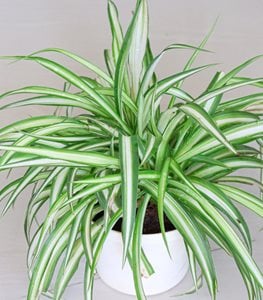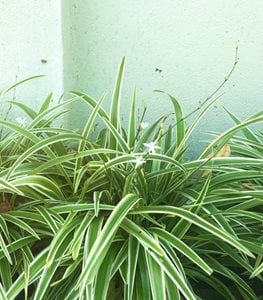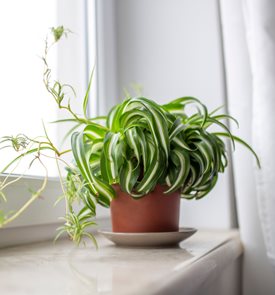HOW TO GROW & CARE FOR SPIDER PLANTS
This old-fashioned, easy-to-grow houseplant never goes out of style. Get planting and care tips, and learn about the latest varieties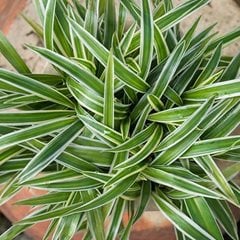
Variegated spider plant. Photo by: Proven Winners
If a spider plant conjures up images of college dorm room décor, that’s because it’s one of the best houseplants for beginners and one of the easiest to propagate and share. As trendy today as it was generations ago, the spider plant creates a living mobile when put in a hanging basket, where its multitude of baby spiders, or “spiderettes”, can dangle freely from their long, arching stems.
If you thought all spider plants looked the same, you’ll be delighted to discover that the attractive, fountainlike foliage comes in an assortment of color variations and forms, including a cultivar with curly leaves. And while they are usually grown indoors, spider plants can also flourish outdoors when given the right conditions.
On this page: Basics | Planting | Care and Maintenance | Varieties | Display Ideas
On this page:
- BASICS
- PLANTING SPIDER PLANTS
- SPIDER PLANT CARE AND MAINTENANCE
- HOW TO PROPAGATE SPIDER PLANT
- SPIDER PLANT VARIETIES
- DISPLAY IDEAS
SPIDER PLANT BASICS
Botanical name:
Chlorophytum comosum
Common names:
Spider plant, airplane plant, ribbon plant, spider ivy, St. Bernard's lily
Origin:
Native to South Africa
Care level:
Easy
Size:
8 to 24 inches tall, up to 36 inches wide
Light requirements:
Bright to moderate indirect light
Growth rate:
Fast, often reaching its full size within a few years
Foliage:
May be solid green or variegated in green and white or green and yellow, depending on the cultivar.
Flower colors:
White, yellow
Is spider plant toxic?
Although spider plant is generally safe for households with children and pets, it contains chemicals that can be mildly hallucinogenic to cats, causing a euphoric effect similar to that of catnip. It’s best to keep the plant out of a cat’s reach because ingesting too much can cause digestive upset.
Other benefits of growing spider plants:
In addition to its wonderfully retro appearance, spider plants can benefit your home’s indoor air quality, filtering out formaldehyde, carbon monoxide, and other harmful impurities.
PLANTING SPIDER PLANTS
Where to plant:
Indoors or outdoors, spider plants prefer a location with bright, indirect light. Although spider plant can tolerate low-light conditions, it needs adequate light in order to bloom and produce offshoots. Avoid direct sunlight, which can scorch the leaves. Can be grown outdoors year-round in warmer climates (Zones 9-11).
Temperature and humidity:
Average household room temperatures (65° to 75° F) and humidities are fine. Keep away from cold drafts and spots near heating and cooling vents. If planting outdoors, avoid exposing to temperatures below 45° F.
Soil type:
Use a well-draining potting mix.
Pot requirements:
As with most houseplants, be sure to use a pot with drainage holes to prevent soggy soil and root rot. Spider plants don’t mind being a bit cramped in their homes, so choose a container that is only slightly larger than your plant’s root ball.
SPIDER PLANT CARE AND MAINTENANCE
Watering:
Spider plants like even moisture but can tolerate some neglect because their thick, fleshy roots are able to store water. A good rule of thumb is to water when the top inch of soil feels dry. Avoid overwatering, which can lead to root rot.
Fertilizing:
Spider plants can also store nutrients in their roots, so they don’t need frequent fertilization. Feed them every two weeks during spring and summer using a water-soluble organic houseplant fertilizer, and less often or not at all during the fall and winter months. Avoid overfertilizing, which can cause brown leaf tips and prevent your plant from producing offshoots.
Pruning:
To keep your spider plant looking its best, prune off any brown leaf tips or edges using a sharp pair of small scissors, following the natural angle of the leaf. Also prune off dead or damaged leaves and unwanted runners by cutting them back to soil level. You won’t harm your plant by removing the stems and plantlets, and you will often improve its health and vigor.
Repotting:
If the roots start pushing through the drainage holes or emerge above the soil surface, it’s time to transplant your plant into a new container. Choose a pot that’s only slight larger than the current one (about 1 to 2 inches) and be sure to refresh the soil to improve drainage.
Pests:
Spider plants are generally pest-free but may occasionally be bothered by mealybugs, scale, and spider mites. Good treatments for getting rid of these insects include washing the leaves with an insecticidal soap and applying organic neem oil. (See more on common houseplant pests.)
Foliage problems:
- If you notice brown leaf tips (also called “tip burn”) on your spider plant, this can be a sign of accumulation of salt in the leaf tips. Make sure the plant is well watered before and after fertilizing and not allowed to dry out too much.
- Tip burn may also be due to too much sunlight or not enough humidity.
- If the sides of the leaves are also brown, it could also be caused by chemicals in the water you are using, particularly fluoride and chlorine. When possible, water your plant with distilled or filtered water instead.
- If the leaves turn pale or lose their color variegation, it is usually a sign that your plant is not getting enough light.
HOW TO PROPAGATE SPIDER PLANTS
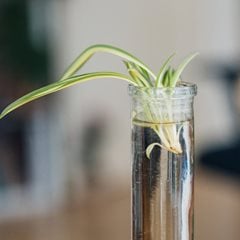
Photo by: Julia Dresch / Shutterstock
Spider plant is so incredibly easy to propagate that you will soon be giving the offspring to all your friends and neighbors. There are several sure-fire methods you can use to grow new plants from your spiderettes.
- Once the baby spiders begin to develop short, stubby roots, simply snip them off their runners (cut the remaining stems back to the base of the mother plant) and stick the roots in some potting soil. Keep the soil consistently moist until you begin to see new leaf growth.
- You can also remove the plantlets before the roots have formed and set them in a glass of water, being careful not to submerge the foliage. After they begin to develop roots, you can pot them up for sharing.
- Use a few of the spiderettes to make the parent plant look fuller by planting them in the soil alongside it and allowing them to take root. Leave the spiderettes attached to the mother plant until the new plants are strong enough to survive on their own.
If your spider plant isn’t producing any babies or is growing too large for its pot, you can also propagate it through division by removing it from its container and separating the roots into clumps using your fingers or garden knife. Start new plants in a clean pot filled with fresh soil.
SPIDER PLANT VARIETIES
'VARIEGATUM'
Chlorophytum comosum 'Variegatum'
Size: 12 to 18 inches, trails up to 12 inches
Strappy green leaves edged in bright white create a cascading, arching mound, from which numerous plantlets sprout on dangling stems. Small, white, star-shaped flowers appear intermittently throughout the season.
VARIEGATED SPIDER PLANT
Chlorophytum comosum 'Vittatum'
Size: 1 to 2 feet tall
The first variegated cultivar of spider plant and still one of the most popular, instantly recognizable by the creamy white stripe running down the center of its long, slender green leaves, all the way from base to tip.
REVERSE VARIEGATED SPIDER PLANT
Chlorophytum comosum 'Reverse Variegatum'
Size: Up to 2 feet tall and 3 feet wide
As the name implies, this plant’s variegation pattern is the reverse of ‘Vittatum,’ featuring elegant green leaves edged in white. A nice change of pace from the more commonplace variety.
'BONNIE' SPIDER PLANT
Chlorophytum comosum 'Bonnie'
Size: 8 inches tall and wide
Take variegated spider plant, give it a perm, and you get ‘Bonnie’—a compact cultivar sporting curly green leaves with creamy white stripes. It also produces lovely yellow flowers rather than the typical white blooms. A good choice if you’re looking for a spider plant that takes up less space.
Also try:
HAWAIIAN SPIDER PLANT
Chlorophytum comosum ‘Hawaiian’
Variegation or no variegation? This unusual cultivar offers a bit of both, starting out with young leaves variegated in green and white that fade to all green as the leaves mature, then continuing the cycle by producing babies with variegation again, creating a nice contrast with the parent plant.
ZEBRA SPIDER PLANT
Chlorophytum laxum ‘Zebra’
Looks very similar to ‘Reverse Variegatum’ but with bright yellow edges that eventually turn white. Tends to grow shorter and wider than other varieties.
DISPLAY IDEAS
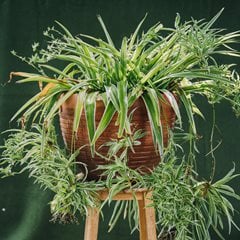
Photo by: Aunyaluck / Shutterstock
Here are some suggestions on how to display your spider plants indoors or out in the garden:
- In baskets or pots held by decorative macramé hangers (see more indoor hanging plants)
- On a pedestal, mantle or high shelf where the offshoots can cascade freely
- Outdoors in window boxes or on top of garden walls
- As a filler or spiller in mixed container plantings
- In shady garden beds, as a grassy groundcover
RELATED:
21 Best Indoor Plants
Best Low-Light Houseplants
A Guide to Growing Peace Lily
A Guide to Growing Pothos

